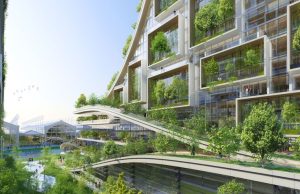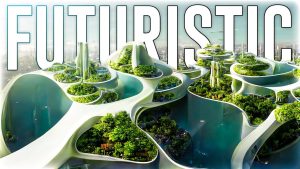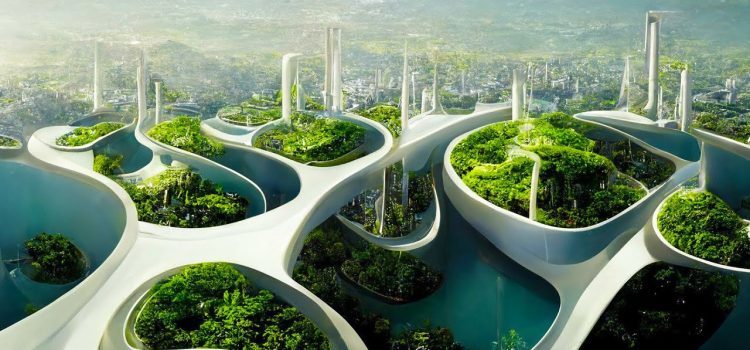
Introduction
In 2025, cities are changing, and green architecture is at the heart of this Transformation. As urban areas grow, they cause more pollution, use more energy, and have fewer natural spaces. Green architecture is a solution to these problems. It focuses on building buildings that help the environment and make life better for people.
Green architecture is making cities smarter, cleaner, and better places to live. Instead of traditional buildings that waste a lot of resources, green buildings are designed to be more energy-efficient, use less water, and help people stay healthy. They also use nature in their designs. By making these changes, green architecture is helping cities become more sustainable.
In this article, we will talk about how green architecture is changing the way we live in cities and making urban spaces more sustainable and eco-friendly.
What is Green Architecture?
Green architecture is all about designing buildings that are good for the planet and for people. It includes using energy-saving systems, eco-friendly materials, and ways to reduce waste. The goal of green architecture is to make buildings that use less energy, save water, and improve indoor air quality.
This approach also means using resources in ways that don’t harm the environment, making sure that future generations can still enjoy clean air and water. For example, green buildings often use solar panels to capture energy from the sun and rainwater harvesting systems to collect water. These ideas help create buildings that are good for the environment and people living in the city.
How Green Architecture Is Changing Cities in 2025
1. Energy Efficiency and Smart Systems

One of the most important parts of green architecture is using less energy. Traditional buildings use a lot of energy for heating, cooling, and lighting. But green buildings use smart systems to cut down on energy use. They often have solar panels on the roof to capture the sun’s energy, energy-efficient windows that help keep the building cool in the summer and warm in the winter, and LED lighting that uses less electricity.
Geothermal systems are another smart system that green buildings use. These systems use the heat from deep in the ground to warm and cool buildings. Green buildings can also use smart thermostats to automatically adjust the temperature based on the weather, reducing energy use even more.
By using these energy-efficient systems, green buildings help reduce the amount of energy used, lowering both the building’s environmental impact and energy costs.
2. Sustainable Materials

Another feature of green architecture is the use of sustainable materials. Traditional building materials, like concrete and steel, take a lot of energy to make and often harm the environment. Green buildings use materials that are better for the environment, like bamboo, recycled wood, and recycled steel.
Bamboo is a popular material because it grows quickly and can be replaced easily, unlike trees. Recycled materials help reduce waste and the need for new resources. Green buildings also focus on materials that are healthy for people. For example, non-toxic paints and natural finishes help improve indoor air quality.
Using these sustainable materials helps reduce waste, saves energy, and makes green buildings better for the planet.
3. Urban Green Spaces and Nature Integration

One of the most exciting parts of green architecture is the addition of green spaces in cities. Many cities are full of concrete and steel, which doesn’t give people much space to connect with nature. Green architecture is changing this by adding green roofs, vertical gardens, and public parks to buildings. These spaces improve the air quality, reduce noise, and give people a place to relax.
Adding plants to buildings and city spaces helps clean the air by absorbing carbon dioxide and releasing oxygen. Green spaces also help cool down the temperature in cities by providing shade and releasing moisture into the air.
In 2025, we’re seeing more green buildings with plants and trees, creating healthier, more pleasant places to live. These spaces not only benefit people but also help support wildlife, improving biodiversity in cities.
4. Water Conservation

Water conservation is another key part of green architecture. In many cities, water is becoming a scarce resource, especially in dry areas. Green buildings are designed to use water wisely by collecting rainwater, recycling water, and using efficient plumbing systems.
Rainwater harvesting systems collect rainwater from rooftops and store it for later use, like watering plants or flushing toilets. This reduces the amount of water needed from the city’s water supply. Low-flow toilets and showerheads are other water-saving features found in green buildings. These fixtures use less water while still being effective.
By saving water, green buildings help preserve this valuable resource and reduce the cost of water for both residents and businesses.
5. Health and Well-being

Another big advantage of green architecture is that it helps create healthier living environments. Traditional buildings often use materials that release harmful chemicals, like formaldehyde, which can affect people’s health. Green buildings avoid these chemicals by using non-toxic materials and improving indoor air quality.
Green buildings also focus on providing more natural light and fresh air. For example, many buildings are designed with big windows and open spaces that let in sunlight, reducing the need for artificial lighting. Natural light has been shown to improve mood and productivity, making green buildings better for both health and happiness.
In addition to the physical benefits, green architecture encourages outdoor spaces that help reduce stress and improve mental health. Access to green spaces has been shown to reduce anxiety and depression, making cities with green architecture more pleasant to live in.
The Benefits of Green Architecture

The use of green architecture in cities offers many benefits. Here are some of the main advantages of green buildings:
- Lower Utility Costs: Green buildings use less energy and water, which means lower bills for both residents and businesses.
- Healthier Living: With better air quality and access to nature, people in green buildings enjoy a healthier living environment.
- Increased Property Value: Because they are energy-efficient and eco-friendly, green buildings are often worth more than traditional buildings.
- Environmental Sustainability: Green architecture helps reduce pollution, conserve resources, and protect the environment.
- Better Quality of Life: Access to green spaces and natural light improves mental and physical health, making life better for everyone.
The Future of Green Architecture

As technology advances, green architecture will continue to evolve and improve. In the future, we can expect to see even more green buildings with smarter systems and more sustainable designs. Some trends we might see in the next few years include:
- Smarter Systems: Green buildings will become even more energy-efficient with technologies like smart thermostats, automated lighting, and better energy storage systems.
- More Green Spaces: Cities will continue to add green spaces to buildings, parks, and streets, improving air quality and making cities more enjoyable to live in.
- Affordable Green Building Materials: As demand for sustainable materials grows, the cost of using them will go down, making green architecture more affordable for everyone.
In 2025 and beyond, green architecture will play an important role in making cities cleaner, greener, and more sustainable. It will help solve many of the challenges cities face today, like pollution, high energy use, and a lack of natural spaces.
Table: Key Benefits of Green Architecture
| Benefit | Explanation |
|---|---|
| Energy Efficiency | Green buildings use less energy, saving money and reducing pollution. |
| Sustainable Materials | Green buildings use eco-friendly materials like bamboo and recycled wood. |
| Green Spaces | Green buildings include outdoor spaces that improve air quality and provide places to relax. |
| Water Conservation | Green buildings save water by collecting rainwater and using efficient plumbing. |
| Health and Well-being | Green buildings improve air quality and provide access to nature, making people healthier and happier. |
Conclusion
Green architecture is reshaping the future of urban living. In 2025, it is helping cities become smarter, cleaner, and more sustainable. Green buildings use energy-efficient systems, sustainable materials, and Healthy Designs to reduce the impact of cities on the environment. By creating green spaces, conserving water, and improving air quality, green architecture is making urban life better for everyone.
As more cities adopt green architecture, we can expect cities to become even more eco-friendly and pleasant to live in. The future of green architecture is bright, and it will continue to play a key role in building sustainable cities for generations to come.










